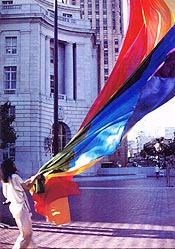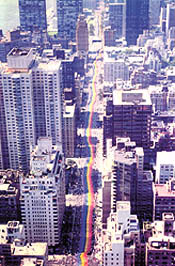

 Gilbert Baker displays the very first Gay Pride flag in 1978 |
The Rainbow Flag made its first appearance
in the San Francisco Gay and Lesbian Freedom Day Parade in 1978. Its
symbolism was borrowed from the hippie and black civil rights movements.
Artist Gilbert Baker from San Francisco, our own gay Betsy Ross, created the flag as a symbol that
could be used year after year. Along with about 30 volunteers, two gigantic prototype of the flag were hand-stitched and hand-dyed. The original flag had eight stripes, with each color representing a particular component of the gay community: hot pink for sex, red for life, orange for healing, yellow for sun, green for nature, turquoise for the arts, indigo for harmony, and violet for spirit. The following year, as a result of extraordinary demand for the flag, Baker contacted San Francisco Paramount Flag Company to inquire about the possibility of mass-producing his flag for use in the 1979 parade. He was surprised to learn that due to production issues and the fact that hot pink was not a readily available commercial color, his original eight colors could not be used. The fact is that he had hand-dyed the original colors. Hot pink was removed from the palette and the flag was reduced to seven stripes, with indigo being replaced by royal blue. |
||||
 New York City - 1994 |
The second change to the flag came after the assassination
of San Francisco's openly-gay commissioner, Harvey Milk. To manifest
the community's solidarity in the aftermath of this tragedy, the San
Francisco Pride Committee elected to use Baker's flag in honor of the
slain Milk. The turquoise stripe was eliminated so that the colors
could be divided evenly on the parade route, three colors on one side of
the street, and three colors on the other side. |
||||
| In 2004 at the Key West Pride Festival, Gilbert Baker unveiled a re-creation of his original eight-color flag. Said Baker, "We lost two of the original colors, pink and turquoise. Itís time, however, to restore the original design. First, it is simply more beautiful and more authentic. Moreover, when we lost the pink, we lost the symbol for our sexual liberation. The missing turquoise honors Native Americans and the magic of life. Both colors are needed to embrace our history." | |||||
|
|
|||||
this page updated on 6/14/2016
info@gayprideneworleans.com
![]()